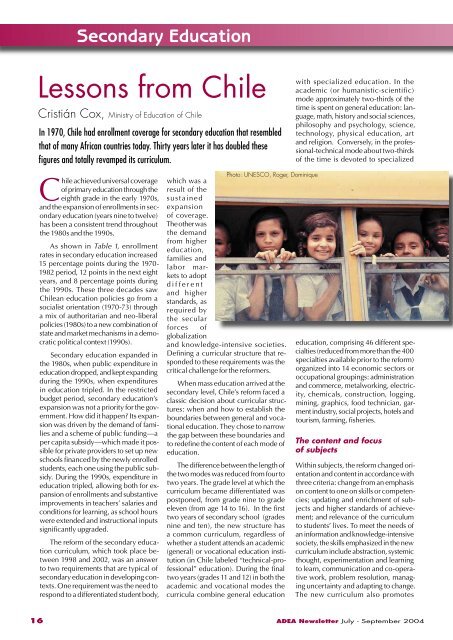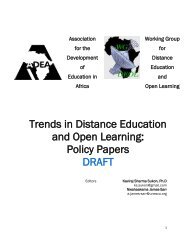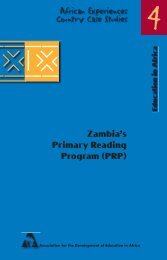Newsletter Vol.16 No.3 - ADEA
Newsletter Vol.16 No.3 - ADEA
Newsletter Vol.16 No.3 - ADEA
You also want an ePaper? Increase the reach of your titles
YUMPU automatically turns print PDFs into web optimized ePapers that Google loves.
Secondary EducationLessons from ChileCristián Cox, Ministry of Education of ChileIn 1970, Chile had enrollment coverage for secondary education that resembledthat of many African countries today. Thirty years later it has doubled thesefigures and totally revamped its curriculum.with specialized education. In theacademic (or humanistic-scientific)mode approximately two-thirds of thetime is spent on general education: language,math, history and social sciences,philosophy and psychology, science,technology, physical education, artand religion. Conversely, in the professional-technicalmode about two-thirdsof the time is devoted to specializedChile achieved universal coverageof primary education through theeighth grade in the early 1970s,and the expansion of enrollments in secondaryeducation (years nine to twelve)has been a consistent trend throughoutthe 1980s and the 1990s.As shown in Table 1, enrollmentrates in secondary education increased15 percentage points during the 1970-1982 period, 12 points in the next eightyears, and 8 percentage points duringthe 1990s. These three decades sawChilean education policies go from asocialist orientation (1970-73) througha mix of authoritarian and neo-liberalpolicies (1980s) to a new combination ofstate and market mechanisms in a democraticpolitical context (1990s).Secondary education expanded inthe 1980s, when public expenditure ineducation dropped, and kept expandingduring the 1990s, when expendituresin education tripled. In the restrictedbudget period, secondary education’sexpansion was not a priority for the government.How did it happen? Its expansionwas driven by the demand of familiesand a scheme of public funding—aper capita subsidy—which made it possiblefor private providers to set up newschools financed by the newly enrolledstudents, each one using the public subsidy.During the 1990s, expenditure ineducation tripled, allowing both for expansionof enrollments and substantiveimprovements in teachers’ salaries andconditions for learning, as school hourswere extended and instructional inputssignificantly upgraded.The reform of the secondary educationcurriculum, which took place between1998 and 2002, was an answerto two requirements that are typical ofsecondary education in developing contexts.One requirement was the need torespond to a differentiated student body,which was aresult of thesustainedexpansionof coverage.The other wasthe demandfrom highereducation,families andlabor marketsto adoptdifferentand higherstandards, asrequired bythe secularPhoto: UNESCO, Roger, Dominiqueforces ofglobalizationand knowledge-intensive societies.Defining a curricular structure that respondedto these requirements was thecritical challenge for the reformers.When mass education arrived at thesecondary level, Chile’s reform faced aclassic decision about curricular structures:when and how to establish theboundaries between general and vocationaleducation. They chose to narrowthe gap between these boundaries andto redefine the content of each mode ofeducation.The difference between the length ofthe two modes was reduced from four totwo years. The grade level at which thecurriculum became differentiated waspostponed, from grade nine to gradeeleven (from age 14 to 16). In the firsttwo years of secondary school (gradesnine and ten), the new structure hasa common curriculum, regardless ofwhether a student attends an academic(general) or vocational education institution(in Chile labeled “technical-professional”education). During the finaltwo years (grades 11 and 12) in both theacademic and vocational modes thecurricula combine general educationeducation, comprising 46 different specialties(reduced from more than the 400specialties available prior to the reform)organized into 14 economic sectors oroccupational groupings: administrationand commerce, metalworking, electricity,chemicals, construction, logging,mining, graphics, food technician, garmentindustry, social projects, hotels andtourism, farming, fisheries.The content and focusof subjectsWithin subjects, the reform changed orientationand content in accordance withthree criteria: change from an emphasison content to one on skills or competencies;updating and enrichment of subjectsand higher standards of achievement;and relevance of the curriculumto students’ lives. To meet the needs ofan information and knowledge-intensivesociety, the skills emphasized in the newcurriculum include abstraction, systemicthought, experimentation and learningto learn, communication and co-operativework, problem resolution, managinguncertainty and adapting to change.The new curriculum also promotes16 <strong>ADEA</strong> <strong>Newsletter</strong> July - September 2004
















